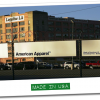Photo from: It’s Okay to Like American Apparel.
Behind the Brand Video: the key to AA’s $$ is Sweatshop-free, Vertical Integration.
But where do they source their cotton? Info on their sustainable initiatives, from their site:
Being sustainable is an inherent part of the American Apparel business model. Vertical Integration reduces our footprint by concentrating our manufacturing operations to a small circle of buildings in Southern California – that means we’re not needlessly shipping supplies all over the world. Because they are our factories, where we pay the bills, we’ve lined up our incentives to be as efficient as possible. Most importantly, since our employees all share the same space – from the designers to the accountants to the sewers – we wouldn’t tolerate unsanitary conditions. It also gives us the ability to facilitate environmentally friendly transportation.
Here are just a few of the ways that we work sustainability into our brand:
ScrapsWe strive to be as efficient as possible, creating as little waste as we can. Here are some of the ways we reduce our scrap factor in production:
Mixed Markers – As much as possible, we try to minimize the gaps between pattern pieces when cutting our garments. We rank styles by efficiency. For really inefficient styles, we find complementary styles that, when cut together, drastically reduce the amount of waste generated.
Accessory Styles – When we can’t get any more efficient with the use of existing patterns, we take a critical look at the gaps left over. What others see as waste, we see as inspiration. From these gaps in patterns have come our scrunchies, hair bows, and a wealth of other accessories, with new additions being created all the time.
Bag O Scraps – What we can’t make use out of, maybe
you can.Rags – What we can’t turn into product, we cut into rags and distribute to our Housekeeping team.
Recycling – And what’s not big enough for rags? We sell off to third parties who in turn recycle them.
Creative Re-useInstead of tossing packaging or supplies we can no longer use – such as the spools thread comes on, or cardboard tubes at the center of large rolls of paper– we donate as much as possible back to local schools and non-profits for use in arts programs. If you are interested in supplies for your art program, just send us an e-mail.
Solar PanelsAmerican Apparel houses a state-of-the-art solar panel installation on the roof of our downtown LA factory. This system generates 150 kilowatts of clean, renewable power, contributing up to 15% of our energy needs.
Organic LineAll the products sold under the “Sustainable Edition” label at American Apparel feature 100% organic cotton. In 2008, we purchased over 30,000 pounds of organic cotton from the Cleaner Cotton Initiative in California. Like all our cotton, we try to buy as much local or domestic organic cotton as we can. We sell over 80,000 100% organic cotton garments every year.
TransportationBike Program – We’ve been lending bikes to employees since 2005, to provide a sustainable alternative for commuting. We generally have over 150 bikes lent out at any given time, along with locks and helmets, at all of our factories in the LA area
Subsidized Bus Passes – To encourage use of public transportation, we offer employees a discounted rate on monthly Metro passes for unlimited use in the LA metro area.
New, lovely Tara Stiles doing yoga for American Apparel photos.
I’ve taken these photos down, at Tara’s request, because we like her. Though we only featured those AA yoga photos we considered lovely and tasteful, Tara would prefer these ads go away—so, though they’re on AA’s home page and on Google, please do our friend a favor and don’t use them for your blog, either. ~ed.
I left out the more saucy/sexy/too-sexy ones, but Tara’s photos are featured on the home page of American Apparel, right now. Not too hard to find.
Interesting: below is an internal AA video meant for investors and business types that tells us what AA is thinking behind why they pay their workers well and make their clothes in the USA, “defying conventional wisdom,” and why their ads are so consistently…er, controversial.




















Read 4 comments and reply